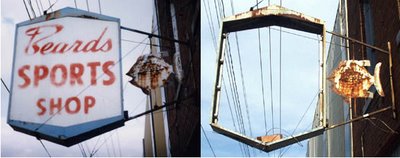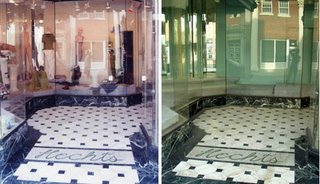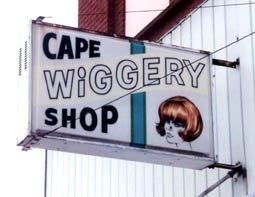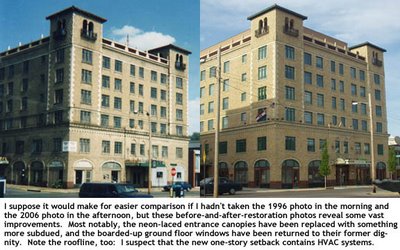 Built in 1928, the Marquette was a respectable destination for about half a century. As the chain motels out by the interstate took more and more of travelers’ business, the downtown hotels closed and fell into disrepair. The Marquette was threatened with demolition in the ‘90s, but recently rebounded as a freshly-rehabbed tower of apartments and offices.
Built in 1928, the Marquette was a respectable destination for about half a century. As the chain motels out by the interstate took more and more of travelers’ business, the downtown hotels closed and fell into disrepair. The Marquette was threatened with demolition in the ‘90s, but recently rebounded as a freshly-rehabbed tower of apartments and offices.
When I first saw and photographed the Marquette in the mid-‘90s, it was at its lowest point. Through the dusty glass doors I saw a once-proud lobby littered with dirty mattresses and other debris, and the neon signs were broken and rusty.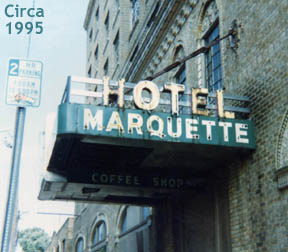 To me, the most intriguing part of the Marquette was the storefront at its southeast corner. THAD BULLOCK'S PIANO SALON had obviously been out of business for a while; the instruments I could see through the window had keys like crooked teeth, and the newest song I could see on a display of sheet music was “Mama Told Me (Not to Come).” A fast-food soda cup of more recent vintage revealed that someone had recently been inside, however.
To me, the most intriguing part of the Marquette was the storefront at its southeast corner. THAD BULLOCK'S PIANO SALON had obviously been out of business for a while; the instruments I could see through the window had keys like crooked teeth, and the newest song I could see on a display of sheet music was “Mama Told Me (Not to Come).” A fast-food soda cup of more recent vintage revealed that someone had recently been inside, however.
As I walked around the back of the building, I saw two old vans bearing Bullock’s name in the parking lot. Both were rusty and had broken windows, and while one was obviously a piano-delivery truck, the other revealed Bullock’s political aspirations. Now I was really curious about this guy, and when I got home I searched the library’s newspaper index for his name and asked former Cape residents about him. The following account was gleaned from St. Louis Post-Dispatch articles and possibly exaggerated anecdotes; any concerned Bullocks who stumble across this text should keep in mind that I present the following not as pure fact, but as a combination of Biographical Thad and Thad-As-Local-Legend.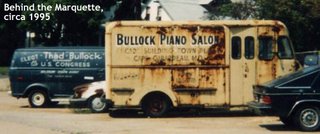 Thad Bullock was already selling pianos by the 1950s, but he didn’t move his Salon into the Marquette building until later. He purchased the entire building in 1969, by which time it’s reasonable to assume that the hotel’s downward slide had already begun. After the hotel proper closed, the Piano Salon remained in business for quite a while longer while Thad also pursued his political interests. He ran unsuccessfully for Mayor, but eventually gained a seat as a Missouri Representative. He is remembered as a morally-conservative Democrat, a cantankerous-yet-gregarious character who built an organ into a small trailer so he could jam for constituents on the campaign trail. A Cape resident remembers his last Thad sighting: During a downtown parade, Bullock showed up and unlocked his long-shuttered Piano Salon so he could sit in the doorway and watch the festivities from his lawn chair… blissfully unaware, hopefully, that his fly was open the entire time.
Thad Bullock was already selling pianos by the 1950s, but he didn’t move his Salon into the Marquette building until later. He purchased the entire building in 1969, by which time it’s reasonable to assume that the hotel’s downward slide had already begun. After the hotel proper closed, the Piano Salon remained in business for quite a while longer while Thad also pursued his political interests. He ran unsuccessfully for Mayor, but eventually gained a seat as a Missouri Representative. He is remembered as a morally-conservative Democrat, a cantankerous-yet-gregarious character who built an organ into a small trailer so he could jam for constituents on the campaign trail. A Cape resident remembers his last Thad sighting: During a downtown parade, Bullock showed up and unlocked his long-shuttered Piano Salon so he could sit in the doorway and watch the festivities from his lawn chair… blissfully unaware, hopefully, that his fly was open the entire time.
Thad Bullock died in 1999, and surviving family members allowed the business deal that brought the Marquette back to life. His name is invoked at the hotel to this day. When, during renovation, an elevator got stuck between floors, a passenger who wrote for the local paper cheerfully blamed “the ghost of Thad Bullock.” Broadway was the main destination for moviegoers in Cape Girardeau, as it was home to three cinemas up till the early ‘80s. The Rialto (circa 1940) was the first to stop showing movies, but it was renamed the Concord and put to good use by a theater group for the remainder of the decade. The much older BROADWAY THEATRE closed down around 1960, but was remodeled (with the hideous aluminum façade seen below) a decade later by the Kerasotes chain. It became a church in the ‘80s, but returned to the movie business for a while in the ‘90s. Now closed and used for storage, the Broadway has a lobby full of random junk and a bunch of broken, boarded-up windows.
Broadway was the main destination for moviegoers in Cape Girardeau, as it was home to three cinemas up till the early ‘80s. The Rialto (circa 1940) was the first to stop showing movies, but it was renamed the Concord and put to good use by a theater group for the remainder of the decade. The much older BROADWAY THEATRE closed down around 1960, but was remodeled (with the hideous aluminum façade seen below) a decade later by the Kerasotes chain. It became a church in the ‘80s, but returned to the movie business for a while in the ‘90s. Now closed and used for storage, the Broadway has a lobby full of random junk and a bunch of broken, boarded-up windows.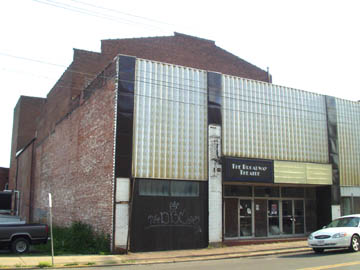 The last cinema to open on Broadway was 1947’s visually arresting ESQUIRE. Its Streamline Moderne façade has held up extremely well, despite many years of vacancy interspersed with stints as a church and a nightclub. Like the Broadway, the Esquire is supposedly in line for renovation.
The last cinema to open on Broadway was 1947’s visually arresting ESQUIRE. Its Streamline Moderne façade has held up extremely well, despite many years of vacancy interspersed with stints as a church and a nightclub. Like the Broadway, the Esquire is supposedly in line for renovation.
Other nostalgic sights along Broadway include WALTHER'S, a former undertaker/furniture store currently awaiting a new tenant…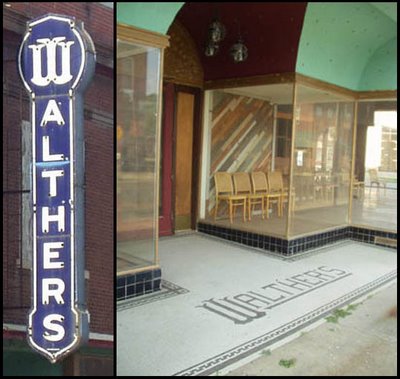

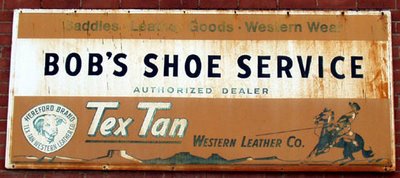
BOB'S SHOE REPAIR is hard to miss, with its giant boot. SHIVELBINE'S music store is still going strong, as is its two-story-tall rotating sign—which, encouragingly, still rotates.
SHIVELBINE'S music store is still going strong, as is its two-story-tall rotating sign—which, encouragingly, still rotates.
BEARD'S SPORTS SHOP closed in 2003 after 44 years in business, but the shop’s new tenant allowed Beard’s distinctive metal fish to remain on the façade.
 While Cape Girardeau has its touristy side, it’s also a college town—and Southeast Missouri State University has attracted plenty of student-friendly businesses to a particular stretch of Broadway. Pizza parlors, sandwich shops and bars prosper near the campus. Cape Girardeau, I’m told, is also home to the second oldest gay bar in Missouri.
While Cape Girardeau has its touristy side, it’s also a college town—and Southeast Missouri State University has attracted plenty of student-friendly businesses to a particular stretch of Broadway. Pizza parlors, sandwich shops and bars prosper near the campus. Cape Girardeau, I’m told, is also home to the second oldest gay bar in Missouri. Another old business district in Cape is located along GOOD HOPE STREET on the south side of downtown. For years it was home to the (razed) Orpheum Theater and a host of restaurants, stores and taverns. These days it appears to be a down-at-the-heels African-American district, characterized by empty storefronts and occasional violence (a successful nightclub recently closed its doors after a murder occurred on the property).
When I’m perusing old city directories at local libraries, I always try to find the oldest operating restaurant and the oldest operating tavern in town. I was a little disappointed to find only one bar that had lasted fifty years: ED'S, on Good Hope. The 2000 Polk Directory indicated that the name had been changed to “JB Taverne,” but when I drove by in May 2006, Ed’s was still the only name visible. I later found out—via the Southeast Missourian’s invaluable “Century of Commerce” feature—that the Corner Pub (renamed Al’s Place), dating back to 1910, is actually the town’s oldest bar. But you still gotta love Ed’s great old neon sign! Other eye-catching south side items are this handsome neon “Alinement” sign (photographed in 2003) and the stunning new BILL EMERSON MEMORIAL BRIDGE over the Mississippi.
Other eye-catching south side items are this handsome neon “Alinement” sign (photographed in 2003) and the stunning new BILL EMERSON MEMORIAL BRIDGE over the Mississippi. (Get more info on this bridge at this site, which I discovered moments ago—and which I’m sure will keep me plenty busy in the future.)
(Get more info on this bridge at this site, which I discovered moments ago—and which I’m sure will keep me plenty busy in the future.) I took these pictures shortly after the demolition in September 2004, when the Illinois approach lay broken on the bank (I swear I heard creepy carousel music coming from the nearby woods while snapping photos) and the decorative arch at the Missouri side was still standing. (Actually, I hope they kept this nice little remnant; I forgot to check when I was there earlier this week.)
I took these pictures shortly after the demolition in September 2004, when the Illinois approach lay broken on the bank (I swear I heard creepy carousel music coming from the nearby woods while snapping photos) and the decorative arch at the Missouri side was still standing. (Actually, I hope they kept this nice little remnant; I forgot to check when I was there earlier this week.)
This probably won't be my last post on Cape Girardeau; due to time constraints, I neglected to check local history books for vintage photos, and I completely forgot to get a shot of the local house that looks like an ocean liner. It's a pretty big town, and I haven't even explored downtown in its entirety, let alone the mid-century beginnings of suburban Cape. In the meantime, here are a couple of valuable resources from the fantastic Southeast Missourian website: A register of local landmarks and a "Century of Commerce" review. I didn't discover these until after my visit, so I'll be sure to take advantage of all this information next time I'm down that way.
